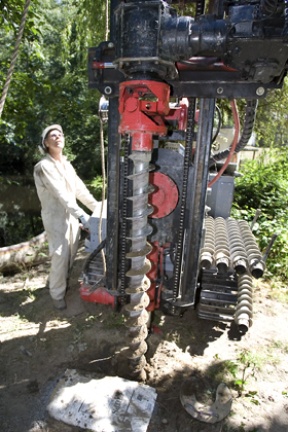Biologists hope to improve fish spawning in Schel-chelb Creek.
Sometime in the 1920s, on the south end of the island, shovels full of dirt choked a portion of Schel-chelb Creek.
The 120-foot long, 12-foot wide earthen dam – built to provide fresh water to a dairy farm nearby – remains intact today, tucked away in the trees behind a quiet residence in Emerald Heights.
As island fish biologist Wayne Daley notes, the placid waters there make for some lovely, leafy reflections. And there are tasty bugs aplenty.
It would be Shangri-La for salmon, if only they could find their way in.
“This habitat is absolutely perfect for rearing juvenile Coho,” Daley said, looking east from atop the dam, where on Thursday a large drill was boring holes to test the dam’s structural integrity.
The testing – performed by a team headed by island geotechnical engineer Vinnie Perrone – is the latest step in an effort to build a fish passage through the dam.
Doing so would open up nearly three-quarters of a mile of new salmon habitat, potentially doubling the amount of spawning salmon there, Daley said.
That would mean the return to the stream of some 30 or 40 adult Coho, instead of the 15 or 20 that return now following their journey to sea.
That number may seem insubstantial, Daley said, but it’s quite an improvement considering the history of the creek.
A major effort in the mid-1990s restored a small estuary in the area, connecting it with a forested wetland.
Biologists say the project, undertaken jointly by private landowners and various agencies, vastly improved conditions there for both Coho and Chum salmon, both of which already inhabit waters on the west side of the dam.
The new habitat created by the proposed fish passage would only be suitable for juvenile Coho, Daly said, but it would be another step toward restoring the state’s salmon habitats, which scientists say are shrinking due to development and other causes.
Some studies estimate that wetlands in Washington and Oregon – wetlands are vital to the health of salmon populations – have diminished by one-third during the past 200 years.
Biologists have noted a corresponding falloff in native salmon populations, including those of Coho and Chum.
Adult Coho can grow to as long as two feet and weigh up to 36 pounds.
They spend the first half of their lives rearing and feeding in small freshwater streams like Schel-chelb before heading to the Pacific Ocean to forage.
Those that survive return to their birth-spot to spawn.
On behalf of Trout Unlimited, the fish and habitat conservation group with which he is affiliated, Daley already has secured a $45,000 grant to fund construction of the passage, which is scheduled to take place next summer.
First, though, Perrone and his team must determine whether it’s safe to breach the dam to create a two- to four-foot wide, three-foot deep passage that would wind for several hundred feet along an adjacent fence-line before reconnecting to the creek.
The passage could be a simple channel or a fish ladder, though the specifics won’t be determined until later in the process.
Perrone’s crew this week bored two 25-foot deep holes into opposite sides of the dam, which extends down some 15 feet. Soil samples, taken by the crew every 18 inches, will be analyzed at Perrone’s laboratory.
At issue is whether the structural integrity of the dam would be compromised by cutting into it to create the fish passage.
Perrone said that depends on the composition of the soil and other factors to be studied over the next two months.
A spillway to the south of the dam would handle overflow during heavy rain, Daley said.
If Perrone gives the okay, work would begin on the engineering and permitting phases. About $20,000 still is needed to complete the entire project.
Trout Unlimited may apply for more grant money, but Daley hopes for help from private donors.
Daley, Perrone and others are donating at least part of their services to the project, which is being done with the blessing of the property owner.
The portion of the creek that would be opened up extends beneath Lynwood Center Road before coming to an end behind Hyla Middle School.
Having already survived the passage of years, Daley, Perrone and others say they hope the dam can handle a different but equally important kind of passage.
“It’s an old dam,” Daley said. “That’s one of the big issues we’re dealing with. But right now, it’s also a barrier for salmon.”


